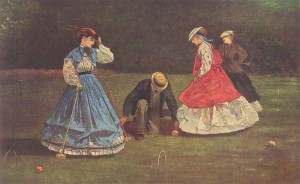 Graduate school ruins your ability to view anything related to your topic of study with an unacademic eye. This is fine if your topic doesn’t come up every day like, say, Byzantine art, but when you choose something that crops up often, like the influence of American music on Continental youth culture in the 1950s, it means you’ll be mentally revising your thesis every time you hear “Johnny B. Goode.” I’m reminded of this phenomenon every Olympiad because I wrote my master’s thesis on sports in Nazi Germany, using the party’s sports policy up until the 1936 Berlin Olympics as a window into their ideas about race and its intersection with political priorities before the war. The fast-approaching 2012 Olympics already have me mentally revising my thesis (something I’m sure I’ll be doing on my death bed), but the most recent issue of our journal Critical Survey has me wondering if I didn’t miss an altogether more interesting topic- sports and gender.
Graduate school ruins your ability to view anything related to your topic of study with an unacademic eye. This is fine if your topic doesn’t come up every day like, say, Byzantine art, but when you choose something that crops up often, like the influence of American music on Continental youth culture in the 1950s, it means you’ll be mentally revising your thesis every time you hear “Johnny B. Goode.” I’m reminded of this phenomenon every Olympiad because I wrote my master’s thesis on sports in Nazi Germany, using the party’s sports policy up until the 1936 Berlin Olympics as a window into their ideas about race and its intersection with political priorities before the war. The fast-approaching 2012 Olympics already have me mentally revising my thesis (something I’m sure I’ll be doing on my death bed), but the most recent issue of our journal Critical Survey has me wondering if I didn’t miss an altogether more interesting topic- sports and gender.
The issue features articles on sports and Victorians, and while they touch on a variety of topics, a recurring theme is the intersection of athletics and gender. Given the centrality of the body and its use to both, it’s unsurprising that discourse on sports reveals assumptions about masculinity and femininity. For Victorians experiencing the upheavals of urbanization, the figure of the sportsman, as Shannon Smith shows, served as a reassuring exemplar of masculine health and heroism. This valorization of the sportsman reflected a changing conception of masculinity itself in which earlier emphasis on virtues without specific gender dimensions like self-control and obedience gave way to a manliness characterized by the muscular physicality exemplified by sports like rugby, as Alan Harvey argues, but at the same time created a difficult to resolve tension between the values of self-control and humility and those of competitiveness and daring.
For female athletes, the relationship between sports and gender has been even more fraught as physical strength and daring clashed with notions of femininity and propiety. Accordingly, Victorian women’s participation in sports required a careful negotiation with gender norms. For example, Erica Munkwitz demonstrates the focus Victorian riding manuals placed on establishing the respectability and appropriateness of women’s participation in riding and fox-hunting, which led to an ever-increasing opportunity for women to participate over the course of the late 19th century. Similarly, in her article, Michelle Beissel Heath presents the rise of croquet during the Victorian era as a phenomenon made possible by its suitability for women who wouldn’t need to exert themselves, move in unladylike ways, or wear immodest clothes. The extent to which ideas about femininity constrained female sports competition is illustrated remarkably in James F. Lee’s article about the British press’s reaction to female footballers. “If a [female footballer] played well and looked the part of a woman, she could be subject to praise; yet if she played well and didn’t conform to the standard of feminine beauty, she faced ridicule, and her gender called into question.”
While contemporary society feels far removed from the Victorians with regard to gender and sports, the distance might not be as great as we like to think. The idea of the male athlete as a heroic embodiment of both the values of a simpler time and of a muscular masculinity remains with us, as evidenced by press encomia to athletes perceived to adhere to traditional values, like baseball player Bryce Harper and football player Tim Tebow, whose supporters argue that they represent not just athletic excellence, but are living affirmations of manly values. And the case of South African runner Caster Semenya who has faced accusations that she is not really a woman and has repeatedly had to prove she is to be allowed to keep competing shows that even today, a female athlete perceived to be too manly can provoke an old-fashioned bout of gender panic. Sports have a way of laying bare assumptions that often pass unnoticed and I think that’s what makes them, for me, such a rich field of study.
